Ukrainian Easter Egg
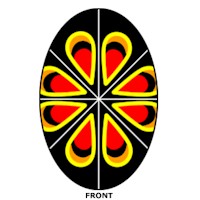
We thought you would like to learn how to make Ukrainian Easter eggs. Once only made at Easter, Ukrainian Easter Eggs, or Pysanky, are now made year ’round by people of varying skill levels all over the world – and they all love it! It can be very addictive!
This craft uses a lighted candle and is not recommended for young crafters. The process will, however, be intriguing to young crafters as they watch the eggs evolve and will act as an introduction to the Ukrainian culture.
Trivia: Learn more about Pysanky symbols and colors as you design your own special eggs.
Supplies
Extra large egg
Candle
Kistka (stylis)
Beeswax
Yellow, Orange, Bright Red and Black dye
Old newspapers
Tissues
Vinegar
Patience
Go to LearnPynsky.com for hints and tricks.
Instructions
You should read through ALL of the instructions at least once before beginning a Ukrainian Easter Egg.
Make your dyes. Instructions for the dyes will come written on the packet outside. Follow them carefully. If it says to add vinegar, do so, but don't add vinegar if it says not to! Dyes like Orange and Pink are weakened/ruined by vinegar, so never add vinegar to them. Once you've made them, let them cool down (you can't use them while they're hot). While they're cooling, take the eggs you'll be using out of the refrigerator, and let them come to room temperature (don't force the eggs to come to temperature in warm water: this can sometimes affect the egg's surface in a negative way).
Draw on the lines as illustrated in the diagram with a pencil. Draw these lines very lightly, and they will not show up in the final design. If you make a mistake with the pencil, do NOT use the eraser on it.
Cover your work area with old newspapers. Have your cooled dyes in jars on the work area. Set your room-temperature eggs on a soft layer of tissues (fold a couple of tissues over in the middle to make a soft "pillow").
Clean your egg with a mixture of diluted vinegar - dab the egg with a tissue dipped in the vinegar solution, or dip the egg in a shallow bowl half-filled with the vinegar solution. Dab the egg dry - never rub.
Heat the head of the kistka in the flame of the candle for 20-30 seconds. Then scoop a little beeswax into the funnel of the kistka. Reheat the kistka in the flame until the wax is melted. If you leave the kistka in the flame too long, it might catch on fire. (Don't worry, they are very easy to blow out!)
Especially in the beginning, you should test the wax flow from the kistka on the newspaper before writing any wax lines on the egg. Occasionally, from over-filling and/or overheating, the kistka will let out a large blob of wax. If this should happen on the egg, there is nothing you can do. The wax bonds instantly to the eggshell; even if you try to scrape the wax off, the blob will still appear in your final design (but you can try to reduce the damage - learn more). Don't feel badly if this happens - even the most experienced egg artist has the occasional blob in their designs. If at all possible, try to incorporate it into the design. If you can't, remember: any art made by humans is going to have mistakes in it - that's what makes each egg truly unique and beautiful.
Use the suggested kistka to apply wax to the egg, everywhere that there are new lines in that step of the design. Remember to apply the wax on BOTH SIDES of the egg. The dye will not go anywhere you apply wax. You'll be using the fine kistka for fine lines, and the heavy kistka for filling in large sections. Keep in mind that the pencil lines are just guides, and you won't be covering all of them with wax. After applying the wax for a color, double check your egg to make sure you didn't miss any lines. Dip the egg in the next dye stated. Leave the eggs in about 15 minutes, or until it is the desired brightness. Remove the eggs with the spoon, and dab dry with tissues. For regular eggs, the dye sequence is from light to dark. For bleached eggs, the sequence can go either way, because the egg's final color is white. You don't need to re-apply wax every time you dip it in a dye; just apply the new lines for the color. Keep going in this way until you have reached the end of the design.
Front (1) shows the egg divided into eighths. You start by drawing one long line around the longest part of the egg, until it meets up with itself. Next, draw a long line at a right angle to this one, until it meets up with itself. Lastly, draw one line around the middle of the egg. Now the egg is divided into 8 equal sized parts.
Now draw two diagonal lines all around the egg, thus dividing it into 16ths.
Front (3): Draw a petal shape on your egg as shown.
Front (4): Draw the remaining petal shapes as shown, trying to keep them equidistant from the center. Remember to draw the petals on both sides of the egg.
Pysanky uses a wax-resist process. You start with the lightest color, white (if you use a white egg). Everything that you want to remain white, you cover with wax, using the kistka (stylus). Then, you dye the egg, usually yellow. Wherever there is wax, the yellow dye will not be able to penetrate. This preserves the white part of the design under the wax. On your yellow egg, you mark with wax all the parts of the design that you want to remain yellow. Then dye it in the next dye bath, in progressively darker colors, add more wax, and so on. In the end, you will have an egg with a great deal of wax on it - if black is your finishing color, you will end up with a virtually black egg. Then, using the side of a candle flame, you melt away the wax, revealing the colors that were protected underneath.
Click on the printables page for the color diagrams.
White
Apply the lines you see on the white egg below- do not apply all of the lines you drew out with the pencil! These were meant as guidelines only. Use the medium or heavy kistka. Apply the lines with long strokes. Remember to test the wax flow from the kistka on newspaper before you write on the egg.
When you have double-checked your lines, dip the egg in the Yellow dye. Wait 15 minutes, or until egg has reached the desired shade (REMEMBER: NO LONGER THAN 45 MINUTES!), then remove it from the dye, and dab it dry.
Yellow
Use the medium or heavy kistka to draw the heavy lines below ion the Yellow Egg.
When you have double-checked your lines, dip the egg in the Orange dye. Wait 15 - 20 minutes, or until egg has reached the desired shade (REMEMBER: NO LONGER THAN 45 MINUTES!), then remove it from the dye, and dab it dry.
Orange
Use the medium or heavy kistka.
When you have double-checked your lines, dip the egg in the Bright Red dye. Wait 15 - 20 minutes, or until egg has reached the desired shade (REMEMBER: NO LONGER THAN 45 MINUTES!), then remove it from the dye, and dab it dry
Bright Red
Use the medium or heavy kistka.
Once you have applied the wax for this colour, double check your lines and dip it in the Black dye. Leave it in for 15 minutes or so, then remove it, and pat it dry. Complete the egg as described in the Finishing Up section.
Finishing Up
When you have finished applying wax to the design, dip the egg in the final color. Wait 15-20 minutes, then remove the egg from the dye, dab it dry, and let it sit a few minutes.
Now comes the really fun part. Take the egg, and hold it near the side of the flame. DO NOT hold the egg over the flame, because carbon will collect on the shell, and darken the design. Wait until the wax looks wet (only a few seconds, usually) and wipe the wax off with a clean tissue. Try to always use a fresh side of the tissue (or a new tissue) for each wipe, or else you'll just be rubbing wax all over the egg, and it will take a lot longer to finish your egg.
You may wish to apply a glossy finish to the egg once completed. You may use clear gloss varnish, varathane, or shellac. Apply a very thin layer of varnish with your fingers and set on the drying rack to dry. However, you may wish to test the gloss on a small surface of the egg first, to see if it makes the colors run (some do).
At this point, you may decide whether to leave the egg intact, or drain the insides. You can buy an egg-blowing device (its fairly cheap) or a syringe to drain the egg. Follow the instructions for emptying that come with the egg blower, or read the brief instructions given on LearnPynsky"s supplies you'll need page. If you do empty it, you should set the egg on the drying rack to let it fully drain. Once that's completed, you can put a little dab of white glue in the holes (stick the tip of a pin in the glue, then apply the glue to the hole). Before doing so, however, you should make a decision about how you will display your egg (filling in the holes may cause complications with this).
Patterns, Templates and Printables
Click on a pattern to open it in a new window
Contributor
Welcome to LearnPysanky.com, also known as How to Make Ukrainian Easter eggs! I've been providing free instructions in this beautiful Eastern European art form online since 1997.





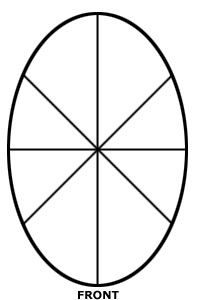
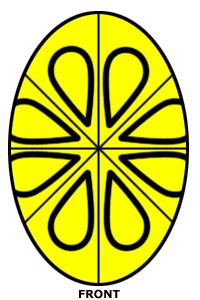
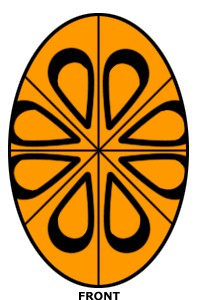
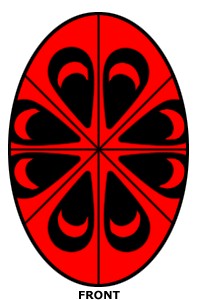
0 thoughts on “Ukrainian Easter Egg”